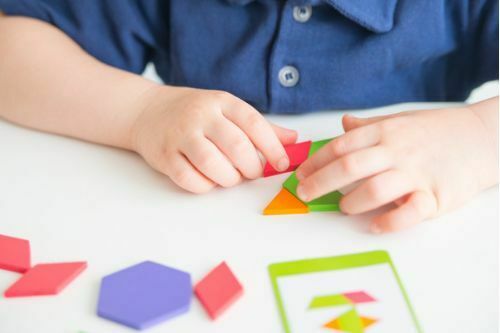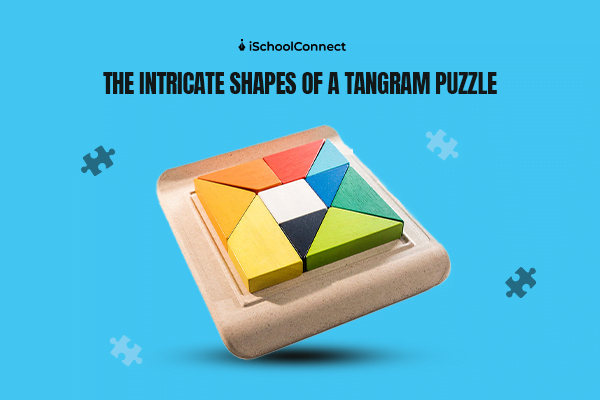Table of Contents
Tangrams, like building blocks or Lego, are a great way of teaching spatial connections. They are an effective tool for students to learn mathematics and geometry.
There are multiple benefits attached to the use of tangrams for learning. Read on to know more about its origination, benefits, and how to play tangram.
History of Tangrams
Tangrams have been around for over 200 years in China. They are puzzles that make use of the fundamental principle of combining basic forms to create larger, more complex tangram shapes and objects. The Chinese puzzle was traditionally a square split into seven parts known as tans. Each of the parts had a unique shape.
What is a Tangram?

When the pieces of the tangram are put together, they imply a wide range of shapes, encapsulating multiple numerical and geometric notions. Tangram pieces are commonly used to solve puzzles that need all seven pieces to be utilized to form a specific shape.
Tangrams are available in four different colors: red, green, blue, and yellow. The three Tangram triangles of various sizes are all right isosceles triangles. As a result, the triangles have 45°, 45°, and 90° angles, and their corresponding sides are proportional.
Cut colored sheets into five triangles, a square, and a parallelogram to make tangrams. We may combine these seven geometric forms to create a variety of other shapes. Tans are the seven separate tangram parts. When the components are placed together, they take on a wide range of shapes and represent a wide range of numerical and geometric concepts. Tangram pieces are often used in puzzle solving. A square may be made by putting all seven parts together.
Why Tangrams?
Tangrams may be used to improve problem-solving, logical thinking abilities, perceptual reasoning, visual-spatial awareness, and creativity. The puzzle further goes to improve numerous mathematical principles, such as congruency, symmetry, area, geometry, and perimeter, just like building blocks.
They aid in the learning of geometric terminology and the development of greater problem-solving skills in children. Students can score better on fundamental arithmetic assessments with the help of a tangram.
One of the most appealing aspects of the puzzle is how basic they are while still allowing for a wide range of sophisticated solutions — it is believed that there are over 1 billion potential conclusions and over 10 million complete shapes that can be formed. In the 19th century alone, 6,500 different tangram shapes and graphics can be formed with tangram and the number keeps growing.
What you can learn

The geometric applications of the Tangram are many. Younger children can concentrate on fitting the pieces into puzzle card forms besides constructing shapes. While developing spatial reasoning skills, children might gain familiarity with geometric figures using tangrams. For some youngsters, spatial skills may be tough, but with practice, they will get easier.
You may learn about links between forms as well as explore and construct shapes.
Tangrams assist students in the middle grades in developing spatial visualization abilities.
Apart from these benefits, the puzzle helps you assess and calm the mind and allows you to introduce concepts easily.
How to play Tangram?
You can play Tangrams in a variety of ways. The general guideline, as well as the old one, is to give the players a specified shape to make with the 7 flat pieces. That is the objective that the participants must achieve. However, for beginners, it’s best to avoid including targets, at least at first.
You should strive to create any complicated shape you want using the 7 ‘tans,’ as long as the complex shape they create has meaning from a geometric standpoint. The ‘tans’ may be rotated and set in different places as desired by the players. You should note that the ‘tans’ should not be overlapping.
What we have to say
- If you love tangrams as much as we do, you might want to invest in a wooden puzzle as it can prove to be a much more durable option.
- Tangram might seem to be a difficult game, but with practice, we assure you that it can refine your cognitive skills, not only helping you with your studies but also in your daily tasks.
Liked the blog? Comment below and share your thoughts with us!
Liked this blog? Read next: 7 Logical reasoning questions to crack any exam | Sample QnAs included!
FAQ’s
Q1. What age is tangram for?
Answer – Tangrams are usually optimal for the age of 5-16.
Q2. What are the 7 shapes in a tangram square?
Answer – The tangram square is made up of seven geometric shapes of which 5 are triangles. These include – 2 small triangles, 1 medium triangle, 2 large triangles, a square, and a parallelogram.
Q3. In what dynasty did the tangram originate in China?
Answer – Tangram originated in China in the Tang dynasty.






